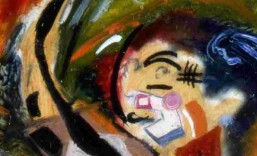Those who know me have often heard me rant against ‘process art’ and its proponents. I am going to reprise those complaints with the end of 2023. So many art ‘hobbyists’ discover and follow a particular process for producing pieces and are ultimately deceived into believing it is art and that they are subsequently legitimate artists. Maybe this is brought about by the commercial success of their product as pure decoration or by inept and misguided peers’ adulation. The use of alcohol inks or acrylic pouring come to mind as prime examples of process disguising as unique art. You can find infinite examples of either process and their mostly identical image results with a simple computer search. If you are producing process art using such methods let me clearly tell you that no, you are not producing art – you are just following a process that results in a pretty object. Art needs meditation and purpose in how marks are applied and images are transferred from the mind to the surface. It is never enough to just depend on a process. Of course we all utilize ‘processes’ in order to transfer and realize images but these processes must be secondary to concept and interpretation, and hopefully invisible. For instance, the use of loading brushes with paint might be considered a ‘process’. The distinction is that the process must be slave to the artist and not vice versa. Artists also use processes to print and realize their images in multiples such as woodcut, silk-screen, lithography, etching, etc. but these processes are never the end in itself and have rather always been seen as legitimate vehicles for realizing personal visions – especially in multiples. The clearest modern example is photography – a technological process (machine) that permits individual personal expression but is dangerously close to being abused as a simple process. To further complicate matters we now have Artificial Intelligence (AI) art that is total process but has exponential expression built on communal or specific images from real artists. The distinction of personal vision from technological process has never been harder to distinguish as with AI and it embodies the same philosophical questions that photography once posed and dominated as the preferred machine process for generating images. Sure we can coax computers toward a personal vision, much like cameras, but where does it stop being a repetitive process and begin being the artist? I don’t think anyone can really tell and so we have widespread opposition to AI images as legitimate art. The best advise if you want to be an artist is to avoid technological tools and concentrate on the basics – handmade personal images using rudimentary tools. Mistakes derived from traditional media never seemed so comforting as when considering an alternative to pure process art.
Tag Archives: photography
Non-plagiarists vs Warhol’s legacy
Artists are lining up on each side of an upcoming October Supreme Court ruling brought on by the Warhol Foundation’s appeal of a lower court ruling barring it from using images without substantially changing them. The American Society of Media Photographers (ASMP), the National Press Photographer’s Association (NPPA), and the US Copyright office are among groups opposing the Warhol Foundation. A ruling in favor of Warhol would diminish the work of any photographer who values their work and puts it in the public realm, making it fair game for lazy artists like Warhol, Barbara Kruger (who lent her name to the Warhol side), Jeff Koons and Richard Prince, among others, who constantly plagiarize images in their work and call it their own with minimal if any changes. If these artists (Warhol rest in peace) want to use a published image in their art without significantly changing it, why shouldn’t they pay the original artist/photographer for the privilege? Or conversely, why not go take your own damn photograph(s) to use? Warhol was never a good draftsman – but he was excellent at pissing on his pieces. His most recognized work such as Marilyn, Elvis, and Mao use photographs, apparently taken by others and used without permission. This is an issue originating in the 20th century with photography but modern society has made it even more easy, through means of the internet, to find and use any image put out for view in the world. It must be noted however that only the most shameless artists plagiarize these works without changing them or seeking permission for them. Many of them are in that modern wing of art that denies showing the ‘artist’s hand’ in works of art – movement famously promoted by Warhol and his ‘factory’. Successful contemporary artists especially should not be given a pass on adopting images without costs. A ruling in favor of the Warhol Foundation will only promote plagiarists as they exploit less successful artists with impunity. Artists prone to using ‘factories’ and ‘assistants’ will find that industrial production of art is not so easy when you have to personally develop all your images. It is not too much to ask for these capitalist artists to sacrifice ease of production for ethical support. BTW there are already laws in most countries that logically migrate published images into the public realm after due time – this case seems to only apply to contemporary images under authorship of current persons. The Copyright office and the photographer groups are correct to oppose this outrageous over-reach by greedy artist-plagiarists and their legacy foundations.
